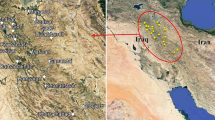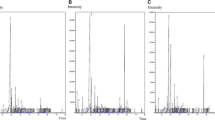Abstract
In 2006, 26 accessions (mainly from Sichuan province, China) in one species and two varietal species among the genus Perilla L. were collected, and the essential oils (EOs) of their fresh leaves during the flowering period were analyzed by the GC-MS method in 2007. In total, 49 components could be identified. The results showed that eight chemotypes could be identified as follows: PK (perillaketone), DLP (d-limonene and piperitone), PT (piperitenone), MS (myristicin), AL (apiol), EM (elemicin), DEK (dehydroelsholtzia ketone) and PA (perilla aldehyde). Of them, chemotype DLP, AL and DEK were reported for the first time; DLP and AL were found only in the accessions from Sichuan province, China. In our study, the EOs of P06-1Z and P06-28 were investigated at several stages during growing. Taking into account the variability of the two accessions during the year, the seasonal influence on the main constituents could not change the status of the different chemotypes distinguished or enhance the veracity of the differentiation of eight chemotypes. The results also suggested that it may not always be possible to establish a correlation between the traditional morphological taxonomy and chemotypes.


Similar content being viewed by others
Abbreviations
- EO:
-
Essential oil
- GC–MS:
-
Gas chromatography–mass spectrometry
- PK:
-
Perillaketone
- DLP:
-
d-Limonene and/or piperitone
- PT:
-
Piperitenone
- MS:
-
Myristicin
- AL:
-
Apiol
- EM:
-
Elemicin
- DEK:
-
Dehydroelsholtzia ketone
- PA:
-
Perilla aldehyde
- UPGMA:
-
Unweighted pair-group method with arithmetic average
- ED:
-
Euclidean distance
- TIC:
-
Total iron chromatographs
References
Chen GG, Zhang JY, Guo YL (2004) Analysis of volatile components of fresh Perilla frutescens (L.) Britt. var. acuta (Thunb.) Kudo by headspace GC/MS. J Essent Oil Res 16:435–436
Honda G, Yuba A, Nishizawa A, Tabata M (1994) Genetic control of geranial formation in Perilla frutescens. Biochem Genet 32(5–6):155–159
Ito M, Toyoda M, Honda G (1999a) Chemical composition of essential oil of Perilla frutescens. Nat Med 53:32–36
Ito M, Toyoda M, Honda G (1999b) Essential oil composition of hybrids and amphidiploids of Japanese wild Perilla. Nat Med 53:118–122
Ito M, Toyoda M, Yuba A, Honda G (1999c) Genetic analysis of Northoapiol formation in Perilla frutescens. Biol Pharm Bull 22:598–601
Ito M, Kiuchi F, Yang LL, Honda G (2002) A new type of essential oil from Perilla frutescens from Thailand. J Essent Oil Res 14:416–419
Ito M, Honda G, Sydara K (2007) Perilla frutescens var. frutescens in northern Laos. Nat Med 10:29–36
Lee JK, Nitta M et al (2002) Genetic diversity of Perilla and related weedy types in Korea determined by AFLP analyses. Crop Sci 42(6):2161–2166
Li HL (1969) The vegetable of ancient China. Econ Bot 23:235–260
Li XW (1974) Flora Reipublicae Popularis Sinicae, vol 65. Science, Beijing, pp 282–287
Liu YX, Zhang WM, Qian XS (1996) Invistigation an utilizing of Perilla. Wilding Resour China 3:24–27
Makino T (1961) Makino new illustrated flora of Japan. Hokuryukan Publishing, Tokyo
Misra L, Husain A (1987) The essential oil of Perilla ocimoides: a rich source of rosefuran. Planta Med 53:379–380
Natta M, Ohnishi O (1999) Genetic relationships among two Perilla crops. Shiso and cgoma, and weedy type revealed by RAPD marks. Genes Genet 74:43–48
Natta M, Lee JK et al (2005) The distribution of Perilla species. Genet Resour Crop Evol 52:797–840
Nitta M, Kobayashi H, Ohnishi-Kameyama M, Nagamine T, Yoshida M (2006) Essential oil variation of cultivated and wild Perilla analyzed by GC/MS. Biochem Syst Ecol 34:25–37
Wilson BJ, Garst JE, Linnabary RD, Channell RB (1997) Perilla ketone: a potent lung toxin from the mint plant, Perilla frutescens Btitt. Science Magazine 5:573–574
Wu ZH, Wu CM, Xu Y (2003) Study on chemical composition of essential oil of Perilla leaves. Amino Acids & Biotic Resour 25(2):18–20
Yu Sl, Wang XL (2006) Nourishment value and comprehensive exploitation of Perilla for medicine. Food Sci Technol 8:287–290
Zeng HY, Zhou PH (2003) Studies on the volatile oils from the leaves of Perilla frutescens (L.) Btitt. J Chin Inst Food Sci Technol 3(2):72–76
Zhao SP, Zhu ZY, Feng YX et al (1993) Studyings on chemical components of essential oil of different chemical type from Perilla frutescens (L.) Btitt. var. argata. and P. frutescens. Nat Prod Res Dev 5(3):8–20
Zheng H, Dong Z, Se J (1997) Mordern study of traditional Chinese medicines,vol 5. Xue Yuan Press, China, pp 4354–4363
Acknowledgments
We are grateful to Prof. GuanghuiYang for the identification of the plant accessions and thank Mr. Erdong Guan for assistance with essential oil extraction.
Author information
Authors and Affiliations
Corresponding author
Rights and permissions
About this article
Cite this article
Zhang, X., Wu, W., Zheng, Y. et al. Essential oil variations in different Perilla L. accessions: chemotaxonomic implications. Plant Syst Evol 281, 1–10 (2009). https://doi.org/10.1007/s00606-009-0152-1
Received:
Accepted:
Published:
Issue Date:
DOI: https://doi.org/10.1007/s00606-009-0152-1




